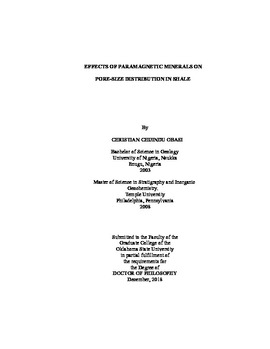| dc.description.abstract | In porous media, effects of internal gradient caused by magnetic susceptibility contrast between the matrix and infilling fluid shifts transverse relaxation (T2) to shorter time, resulting in imprecise classification of pore-sizes. In shale, details of the effects of paramagnetic and clay minerals that induce the internal gradients, are poorly understood. We measured a brine mixture with a granular form of minerals, including kaolinite, montmorillonite, glauconite, illite, pyrite, celadonite, and chamosite, to infer contributions of each to T2 relaxation in shale. The mineral/brine mixtures were compacted in a centrifuge at pressures of 40 (2.75 x 105 Pa), 150 (1.03 x 106 Pa) and 600 (4.14 x 106 Pa) pounds per square inch, respectively. Nuclear magnetic resonance (NMR) response of these samples was used to calculate the total mean logarithm of T2 (T2ML) and volume of water in the samples. Additionally, physical properties such as magnetic susceptibility, specific surface area, and elemental composition were acquired. Pore geometry, magnitude of internal gradients, pore-size distributions, and secular regimes in which the media relaxed (based on their shortest characteristic time scales) were characterized from these properties. These time scales measure the behavior of the relaxation regimes such as longitudinal relaxation time-to-T2 ratio and dependence of relaxation rate on echo spacing (tE). Glauconite illite, pyrite, chamosite, and kaolinite grouped into a small-pore system, whereas montmorillonite and celadonite grouped into large-pores system. A free diffusion regime governed secular relaxation for kaolinite; a motional-averaging regime governed montmorillonite, celadonite and large tE chamosite; whereas a localization regime dominated the rest minerals. We conclude that understanding the effects of internal gradients in shale is important to quantify the shortening of T2ML, which leads to overestimation of bulk fluid volume (BFV) and, thus, underestimating NMR permeability when used as an input into permeability estimator equations. | |
